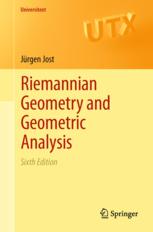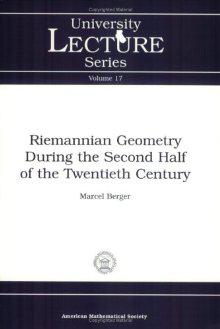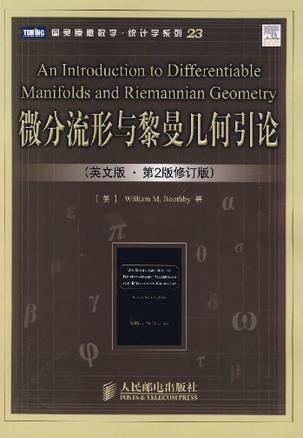-

Riemannian Geometry in an Orthogonal Frame
Elie Cartan's book "Geometry of Riemannian Manifolds" (1928) was one of the best introductions to his methods. It was based on lectures given by the author at the Sorbonne in the academic year 1925-26. A modernized and extensively augmented edition appeared in 1946 (2nd printing, 1951; 3rd printing, 1988). Cartan's lectures in 1926-27 were different - he introduced exterior forms at the very beginning and used orthogonal frames throughout to investigate the geometry of Riemannian manifolds. In this course, he solved a series of problems in Euclidean and non-Euclidean spaces, as well as a series of variational problems on geodesics. The lectures were translated into Russian in the book "Riemannian Geometry in an Orthogonal Frame" (1960). This book has many innovations, such as the notion of intrinsic normal differentiation and the Gaussian torsion of a submanifold in a Euclidean multidimensional space or in a space of constant curvature, an affine connection defined in a normal fibre bundle of a submanifold, and so on. This book was available neither in English nor in French. It has now been translated into English by Vladislav V. Goldberg, currently Distinguished Professor of Mathematics at the New Jersey Institute of Technology, USA, who edited the Russian edition. http://www.amazon.com/Riemannian-Geometry-Orthogonal-Frame-Delivered/dp/9810247478 -

Riemannian Geometry and Geometric Analysis
This established reference work continues to lead its readers to some of the hottest topics of contemporary mathematical research. The previous edition already introduced and explained the ideas of the parabolic methods that had found a spectacular success in the work of Perelman at the examples of closed geodesics and harmonic forms. It also discussed further examples of geometric variational problems from quantum field theory, another source of profound new ideas and methods in geometry. The 6th edition includes a systematic treatment of eigenvalues of Riemannian manifolds and several other additions. Also, the entire material has been reorganized in order to improve the coherence of the book. From the reviews: "This book provides a very readable introduction to Riemannian geometry and geometric analysis. ... With the vast development of the mathematical subject of geometric analysis, the present textbook is most welcome." Mathematical Reviews "...the material ... is self-contained. Each chapter ends with a set of exercises. Most of the paragraphs have a section ‘Perspectives’, written with the aim to place the material in a broader context and explain further results and directions." Zentralblatt MATH -

黎曼几何概论
《黎曼几何概论》中着手本领域比较熟悉的话题,并且尽快过渡到最新科研成果。这些结果并没有给出详细的证明,但一些的重要的结果仍然描述的十分详细生动,使得读者对该领域有详细深刻的理解。然而,黎曼流形作为一个很小的科目,概念的建立需要一个过程,前三章侧重于通过常规的方法引入各种概念和黎曼几何的工具,紧接着详细讲述Gauss和Riemann。 -

Riemannian Geometry During the Second Half of the Twentieth Century
During its first hundred years, Riemannian geometry enjoyed steady, but undistinguished growth as a field of mathematics. In the last fifty years of the twentieth century, however, it has exploded with activity. Berger marks the start of this period with Rauch’s pioneering paper of 1951, which contains the first real pinching theorem and an amazing leap in the depth of the connection between geometry and topology. Since then, the field has become so rich that it is almost impossible for the uninitiated to find their way through it. Textbooks on the subject invariably must choose a particular approach, thus narrowing the path. In this book, Berger provides a truly remarkable survey of the main developments in Riemannian geometry in the last fifty years. One of the most powerful features of Riemannian manifolds is that they have invariants of (at least) three different kinds. There are the geometric invariants: topology, the metric, various notions of curvature, and relationships among these. There are analytic invariants: eigenvalues of the Laplacian, wave equations, Schrödinger equations. There are the invariants that come from Hamiltonian mechanics: geodesic flow, ergodic properties, periodic geodesics. Finally, there are important results relating different types of invariants. To keep the size of this survey manageable, Berger focuses on five areas of Riemannian geometry: Curvature and topology; the construction of and the classification of space forms; distinguished metrics, especially Einstein metrics; eigenvalues and eigenfunctions of the Laplacian; the study of periodic geodesics and the geodesic flow. Other topics are treated in less detail in a separate section. While Berger’s survey is not intended for the complete beginner (one should already be familiar with notions of curvature and geodesics), he provides a detailed map to the major developments of Riemannian geometry from 1950 to 1999. Important threads are highlighted, with brief descriptions of the results that make up that thread. This supremely scholarly account is remarkable for its careful citations and voluminous bibliography. If you wish to learn about the results that have defined Riemannian geometry in the last half century, start with this book. -

Riemannian Geometry
Riemannian Geometry is an expanded edition of a highly acclaimed and successful textbook (originally published in Portuguese) for first-year graduate students in mathematics and physics. The author's treatment goes very directly to the basic language of Riemannian geometry and immediately presents some of its most fundamental theorems. It is elementary, assuming only a modest background from readers, making it suitable for a wide variety of students and course structures. Its selection of topics has been deemed "superb" by teachers who have used the text. A significant feature of the book is its powerful and revealing structure, beginning simply with the definition of a differentiable manifold and ending with one of the most important results in Riemannian geometry, a proof of the Sphere Theorem. The text abounds with basic definitions and theorems, examples, applications, and numerous exercises to test the student's understanding and extend knowledge and insight into the subject. Instructors and students alike will find the work to be a significant contribution to this highly applicable and stimulating subject. -

微分流形与黎曼几何引论
《微分流形与黎曼几何引论(英文版 第2版修订版)》是一本非常好的微分流形入门书。全书从一些基本的微积分知识入手,然后一点点深入介绍,主要内容有:流形介绍、多变量函数和映射、微分流形和子流形、流形上的向量场、张量和流形上的张量场、流形上的积分法、黎曼流形上的微分法以及曲率。书后有难度适中的习题,全书配有很多精美的插图。 《微分流形与黎曼几何引论(英文版 第2版修订版)》非常适合初学者阅读,可作为数学系、物理系、机械系等理工科高年级本科生和研究生的教材。